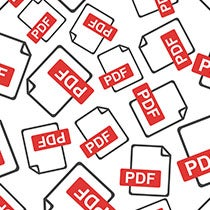When I tell people where I work, I often hear, “I use Adobe every day.” Although Adobe offers a host of products and services, this typically means one thing: they use Acrobat Reader to view and interact with PDF files. Adobe invented the Portable Document Format more than 25 years ago. PDF belongs to the whole world now – it became an international standard in 2008.
On July 28, PDF version 2.0 was released by the ISO (International Organization for Standards). During the last 8 years, experts working in multiple disciplines, industries and countries collaborated to update the 971-page PDF specification, and Adobe engineers and computer scientists played leading roles in its creation. The next generation of PDF strengthens document security, increases accessibility, and enables a superior experience for managing and viewing graphically rich media – 3D, video, geospatial and print. As with any important document that needs to be shared, secured, viewed and printed across devices, the PDF specification was naturally distributed as a PDF file.
Here’s how the PDF is evolving to meet users’ needs
Security. In a cloud-connected world, document-level security is more important than ever. File transmission over the internet can provide openings for unauthorized access to content, if the document itself is not secure. PDF 2.0 improves security management for sensitive material. It requires stronger, state-of-the-art encryption, allows passwords to use non-Roman characters (Unicode), and enables an unencrypted “wrapper” containing information on the encryption method used. This will enable a PDF app or program, such as Acrobat Reader, to better handle the decryption options when an authorized user is ready to view the content.
Accessibility. PDF supports several features which can make content more accessible. For example, alternate text for images can be used by an assistive technology such as text-to-speech conversion, or a braille reader. PDF 2.0 extends and enriches the tagging architecture used to increase accessibility, enabling greater flexibility, and new functionality, for example pronunciation dictionaries.
3D and Multimedia. PDF files are used in several industries to exchange 3D models (e.g. aerospace, equipment prototyping, buildings, biotech, etc.), and also multimedia content (e.g. audio, video). PDF 2.0 adds support for “PRC”, a rich 3D modeling language, originally developed by Adobe. In addition, PDF 2.0 will enable new tools for users to view, measure, and annotate rich media content.
Geospatial. Maps and 3D geospatial objects in PDF 2.0 can be associated with a reference coordinate space or projection. This will enable more sophisticated interactions with data originating from Geospatial Information Systems (GIS), and richer exchange of geographic and scientific content (e.g. satellite imagery, planetary studies, oceanography, astronomy, city planning, forestry, etc.).
Print Color Reproduction. Color accuracy is critical in print workflows, and PDF pioneered modern color management – one reason why commercial printers were early adopters of PDF for the exchange of final job content. PDF 2.0 adds several important features for managing color in print workflows:
- Page-level Output Profiles. PDF 2.0 adds the ability to associate different color profiles to different pages within a job, providing greater flexibility in managing, routing and automating multi-page jobs that will be printed with different stocks, inksets or presses.
- Black Point Compensation. Adobe introduced BPC in Photoshop 5 (2006) to preserve shadow details when converting an image from a larger > smaller colorspace. PDF 2.0 allows a BPC switch to be added to any object, so that BPC conversion can be performed (or not), later in the workflow, e.g. at time of final output.
- Spectrally defined colors. PDF 2.0 allows spot colors to be defined by their spectral values, which will enable greater accuracy in emulating spot colors on digital proofing devices, and in final print reproduction. The increased accuracy and reliability will benefit global brand managers in package printing, industrial printing and textile printing.
With the specification now published, Adobe product teams are studying the workflow implications for users of Acrobat DC, InDesign CC, Illustrator CC, Photoshop CC, and the Adobe PDF Print Engine to see how new application features or tools could be developed to take advantage of new PDF capabilities.
Adobe welcomes the release of PDF 2.0 as an important milestone in the evolution of the standard. We’re excited about its potential to improve proficiency in creative and enterprise workflows, and positively affect all those customers who produce, share, publish and view documents.
